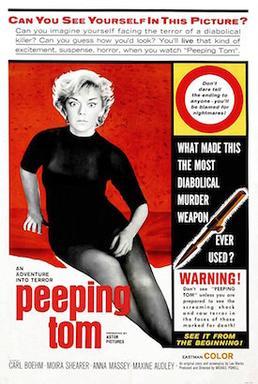Time changes everything. Peeping Tom, which has been on my list for some years, was castigated when it was released in 1960. Now it’s considered a classic. Indeed, it’s frequently discussed in books analyzing horror films, and it had a bit of influence on Alfred Hitchcock. Films like this must be watched as period pieces, of course, but there’s so much psychology here to unpack that I wonder if it’s used in mental health courses. Mark Lewis is a loner who inherited a spacious London house from his father. He lets out the downstairs rooms but keeps to himself upstairs. One of the reasons is that he realizes that he’s mentally unstable. He’s a serial killer, in fact. His young downstairs neighbor takes a shine to him and he reveals, via film, that his father tormented him as a child to film his fear reactions.

As an adult, Mark works in the film industry. He also kills women while filming them to capture their fear reactions—taking his father’s work a step further. Although shy, he is charming enough to others. When he sees a fear reaction, however, he feels compelled to murder. The neighbor downstairs doesn’t suspect him, but her ocularly challenged mother does. Thinking back over it, many moments reminded me of a racier version of Hitch. Racy because Mark picks up money on the side by taking boudoir photographs that the local news shop sells to certain customers. This is a creepy film and perhaps the creepiest scene is where a local girl, well underage, comes into the news shop to buy a candy bar just after the owner sells an older man a pornography book. We don’t like to admit that such things could happen.
There is so much going on in this movie that it’s clear, at least to me, why it has garnered such acclaim. I spent the first twenty minutes or so wondering whether I should really be watching, but as I stayed with it I couldn’t look away (which is one of the very self-reflective issues that the film addresses). The analyses I’ve read never really went into detail regarding the plot, so there were plenty of places where I wondered what would happen next. The pacing is more in keeping with the turn of the sixties, but the mind work seems ahead of its time. Some call it a precursor to slashers, but it doesn’t linger on the actual bloodshed (which is minimal, considering). It does take its time to make you think while you watch. And somehow it makes viewers complicit, it feels, with what they’ve seen.
